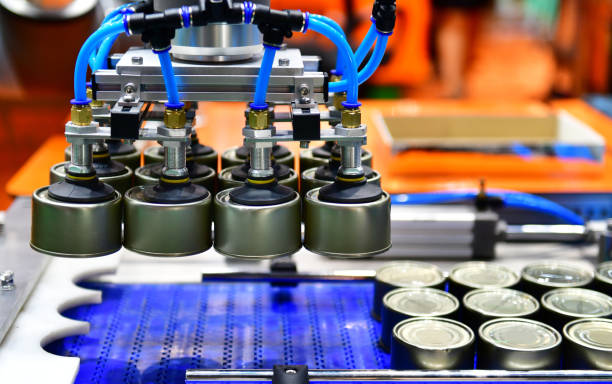
The manufacturing industry has undergone a significant transformation over the years. From manual labor-driven production lines to semi-automated systems, we have now reached an era where robotics plays a crucial role in manufacturing. With the rise of Industry 4.0, robotics and automation have become essential tools for improving efficiency, reducing costs, and maintaining high-quality production standards.
But how exactly do robots impact the manufacturing process? What benefits do they bring, and what does the future hold for robotics in this field? This article explores the role of robotics in manufacturing, the benefits of automation, and how businesses can leverage this technology to stay competitive.
The Evolution of Robotics in Manufacturing
Robotics in manufacturing is not a new concept. The first industrial robot, Unimate, was introduced in the 1960s and was primarily used in automotive manufacturing. Over time, advancements in artificial intelligence (AI), machine learning, and sensor technology have enabled robots to perform more complex tasks with greater precision.
Today, robotic systems can be found in almost every industry, from automobile production and electronics assembly to food processing and pharmaceuticals. Modern manufacturing robots come in various forms, including:
- Articulated Robots: These have rotary joints and are commonly used for welding, assembly, and packaging.
- Collaborative Robots (Cobots): Designed to work alongside humans, cobots improve safety and efficiency.
- Autonomous Mobile Robots (AMRs): These navigate factory floors to transport goods and materials.
- Gantry Robots: Used for heavy lifting and large-scale operations, these robots move along fixed tracks.
Each of these robots plays a unique role in streamlining manufacturing processes, increasing productivity, and minimizing human error.
Key Benefits of Robotics in Manufacturing
1. Increased Productivity and Efficiency
One of the biggest advantages of using robots in manufacturing is the ability to perform tasks faster and more accurately than humans. Robots do not suffer from fatigue, allowing for continuous 24/7 operations. This leads to higher output levels and greater efficiency in production lines.
2. Improved Precision and Quality
Modern manufacturing demands high precision, especially in industries like aerospace, electronics, and medical devices. Robots can execute complex tasks with minimal error, ensuring high-quality products and reducing waste.
3. Cost Reduction
Although the initial investment in robotics can be high, long-term savings outweigh the costs. Robots reduce labor costs, minimize material waste, and improve operational efficiency. Additionally, predictive maintenance and AI-driven analytics help manufacturers optimize production costs.
4. Enhanced Workplace Safety
Manufacturing environments often involve hazardous tasks such as welding, heavy lifting, and handling toxic chemicals. Robots take on these dangerous jobs, reducing the risk of workplace injuries and ensuring compliance with safety regulations.
5. Flexibility and Scalability
Unlike traditional machinery, robots can be reprogrammed and adapted for different tasks. This flexibility allows manufacturers to quickly respond to market demands, customize production lines, and scale operations efficiently.
6. Better Data Collection and Analytics
Smart robots equipped with sensors and AI collect real-time data that can be analyzed to optimize production processes. Manufacturers can use this data to predict equipment failures, improve product design, and enhance supply chain management.
Challenges of Robotics in Manufacturing
While robotics offers numerous benefits, there are also challenges to consider:
- High Initial Investment: Implementing robotics requires a significant financial commitment, which may be a barrier for small and medium-sized enterprises (SMEs).
- Skilled Workforce Requirement: Employees must be trained to operate, maintain, and program robotic systems, which can require additional investment in workforce development.
- Cybersecurity Risks: As robots become more connected through IoT (Internet of Things) and AI, they become vulnerable to cyberattacks. Ensuring data security and system integrity is crucial.
- Job Displacement Concerns: Automation replaces certain manual jobs, raising concerns about unemployment. However, it also creates new job opportunities in robotics engineering, programming, and system maintenance.
The Future of Robotics in Manufacturing
The future of robotics in manufacturing looks promising, with advancements in AI, machine learning, and automation driving further innovation. Some key trends to watch include:
1. AI-Powered Robots
Robots integrated with AI and machine learning can analyze data in real-time, adapt to changes, and make decisions independently. This leads to more efficient production and self-optimizing manufacturing systems.
2. Collaborative Robotics (Cobots) Expansion
Cobots are becoming increasingly popular as they enhance human-robot collaboration. These robots are designed to work safely alongside human workers, boosting productivity and reducing risks.
3. 3D Printing and Robotics Integration
The combination of robotics and additive manufacturing (3D printing) enables rapid prototyping, custom production, and reduced material waste. This technology is expected to revolutionize industries such as aerospace and healthcare.
4. Smart Factories and Industry 4.0
Industry 4.0 is centered around the integration of robotics, IoT, cloud computing, and AI to create fully automated smart factories. These factories will have interconnected systems that communicate seamlessly to optimize production.
5. Sustainable Manufacturing with Robotics
Sustainability is a growing concern in the manufacturing sector. Robotics can help reduce waste, improve energy efficiency, and support environmentally friendly production processes. Companies are increasingly investing in green robotics to meet sustainability goals.
Conclusion
Robotics is no longer a futuristic concept—it is a reality that is transforming the manufacturing industry. From improving efficiency and precision to enhancing workplace safety and reducing costs, robotics plays a vital role in modern production lines. While there are challenges to overcome, the benefits far outweigh the risks, making automation a key driver of industrial growth.
As we move into the future, manufacturers who embrace robotics and automation will gain a competitive edge, while those who resist change may struggle to keep up. The question is no longer whether to adopt robotics, but how quickly businesses can integrate this technology to stay ahead.
Stay tuned for our next article, where we’ll explore how artificial intelligence is revolutionizing cybersecurity and protecting businesses from emerging digital threats.
For more tech insights, visit TechAfri and stay updated on the latest trends in innovation and automation!

